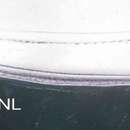Diagnostic Description
provided by Fishbase
Diagnosis: Body somewhat compressed, belly with 6-8 small needle-like pre-pelvic scutes, no post-pelvic scutes; maxilla tip pointed, reaching to or beyond hind border of pre-operculum, the latter concave, indented near maxilla tip; lower gillrakers 24-29; anal fin short, usually with 3 unbranched and 17-20 branched finrays, its origin below about middle of dorsal fin base (Ref. 189, 5430). Of similar species in its distribution area, Stolephorus indicus is round-bodied and has a shorter maxilla, not to hind border of pre-operculum; and Encrasicholina punctifer has the anal fin origin behind the dorsal fin base (Ref. 189).Description: Body somewhat compressed; depth of body 5.0-5.5 times in total length; head length 23-26% of standard length (Ref. 1881, 5430, 122132). Snout pointed, strongly projecting, shorter than the eye; eye diameter 3 times in head length; teeth present in both jaws, minute; maxillary tapering behind, extending to the gill-opening (Ref. 1881, 5430). Lower gill rakers 24-29; upper gill rakers 17-22 (Ref. 5430, 122132). Dorsal fin with 3 unbranched and 12-14 branched rays, originating a little nearer root of caudal fin than end of snout; anal fin with 3 unbranched and 17-20 branched rays, originating below middle of dorsal fin; pectoral fin with 1 unbranched and 11-13 branched rays; pelvic fin with 1 unbranched and 6 branched rays; caudal fin deeply forked (Ref. 189, 1881, 5430). Caudal peduncle twice as long as deep (Ref. 1881). Scales: 38-42 scales in a longitudinal series, 9 in a transverse series (Ref. 1881, 5430). Pre-pelvic scutes 6-8, no post-pelvic scutes (Ref. 5430).Colouration: A silvery lateral stripe is present along flanks (Ref. 1881, 5430).
- Recorder
- Crispina B. Binohlan
Migration
provided by Fishbase
Oceanodromous. Migrating within oceans typically between spawning and different feeding areas, as tunas do. Migrations should be cyclical and predictable and cover more than 100 km.
- Recorder
- Crispina B. Binohlan
Morphology
provided by Fishbase
Dorsal spines (total): 0; Dorsal soft rays (total): 15 - 17; Analspines: 0; Analsoft rays: 20 - 23
- Recorder
- Crispina B. Binohlan
Trophic Strategy
provided by Fishbase
A coastal, pelagic and schooling species; its presence in estuaries suggests that it can tolerate brackish water (Ref. 189). It is common along shore and in estuaries (Ref. 5430).
Biology
provided by Fishbase
A coastal, pelagic and schooling species; its presence in estuaries suggests that it can tolerate brackish water (Ref. 189). It is common along shore and in estuaries (Ref. 5430). It feeds on plankton, mainly copepods (Ref. 58304). It spawns in summer, usually at sea (Ref. 58304).
- Recorder
- Crispina B. Binohlan
Doring-ansjovis: Brief Summary
(
Afrikaans
)
provided by wikipedia AF
Die doring-ansjovis (Stolephorus holodon) is 'n vis wat aan die ooskus van Afrika vanaf Kenia tot by Algoabaai voorkom. In Engels staan die vis bekend as die Thorny anchovy.
- license
- cc-by-sa-3.0
- copyright
- Wikipedia skrywers en redakteurs
Stolephorus holodon: Brief Summary
provided by wikipedia EN
Stolephorus holodon, the Natal anchovy, is a species of ray-finned fish in the family Engraulidae. It is found in the Indian Ocean.
- license
- cc-by-sa-3.0
- copyright
- Wikipedia authors and editors
Stolephorus holodon
(
Basque
)
provided by wikipedia EU
(RLQ=window.RLQ||[]).push(function(){mw.log.warn("Gadget "ErrefAurrebista" was not loaded. Please migrate it to use ResourceLoader. See u003Chttps://eu.wikipedia.org/wiki/Berezi:Gadgetaku003E.");});
- license
- cc-by-sa-3.0
- copyright
- Wikipediako egileak eta editoreak
Stolephorus holodon: Brief Summary
(
Basque
)
provided by wikipedia EU
Stolephorus holodon Stolephorus generoko animalia da. Arrainen barruko Engraulidae familian sailkatzen da.
- license
- cc-by-sa-3.0
- copyright
- Wikipediako egileak eta editoreak
Stolephorus holodon: Brief Summary
(
Dutch; Flemish
)
provided by wikipedia NL
Stolephorus holodon is een straalvinnige vis uit de familie van de ansjovissen (Engraulidae) en behoort derhalve tot de orde van haringachtigen (Clupeiformes). De vis kan een lengte bereiken van 8 centimeter.
- license
- cc-by-sa-3.0
- copyright
- Wikipedia-auteurs en -editors
南非側帶小公魚
(
Chinese
)
provided by wikipedia 中文维基百科
南非側帶小公魚為輻鰭魚綱鲱形目鳀科的其中一種,分布於西印度洋區,從莫三比克北部至南非伊莉莎白港海域,棲息深度可達50公尺,本魚體延長,上頷突出,超過前鰓蓋,臀鰭短,起於背鰭基部中點,臀鰭軟條18-19枚,體長可達8公分,棲息在沿海,喜群游。
參考文獻
南非側帶小公魚: Brief Summary
(
Chinese
)
provided by wikipedia 中文维基百科
南非側帶小公魚為輻鰭魚綱鲱形目鳀科的其中一種,分布於西印度洋區,從莫三比克北部至南非伊莉莎白港海域,棲息深度可達50公尺,本魚體延長,上頷突出,超過前鰓蓋,臀鰭短,起於背鰭基部中點,臀鰭軟條18-19枚,體長可達8公分,棲息在沿海,喜群游。
Description
provided by World Register of Marine Species
A schooling species found in coastal waters. Records from the estuaries Swartskops and Kei Rivers suggest that it can tolerate brackish water. More data needed.
Froese, R. & D. Pauly (Editors). (2023). FishBase. World Wide Web electronic publication. version (02/2023).
- license
- cc-by-4.0
- copyright
- WoRMS Editorial Board

